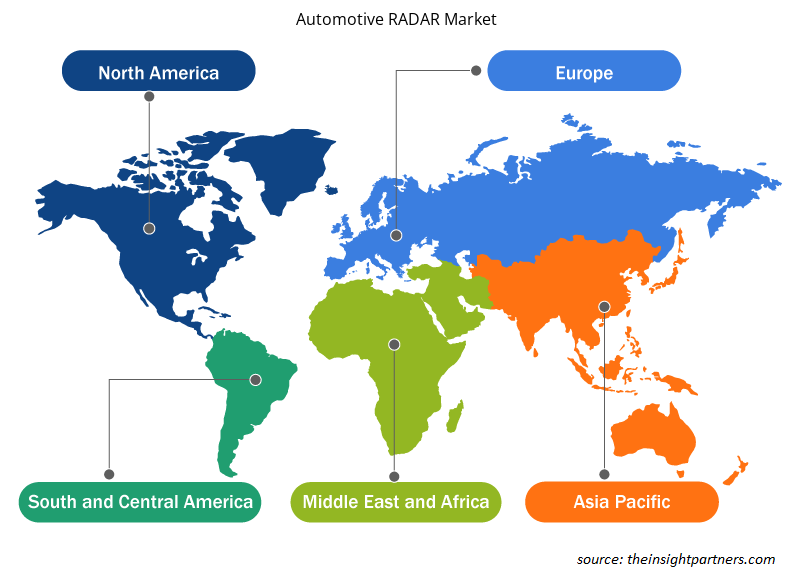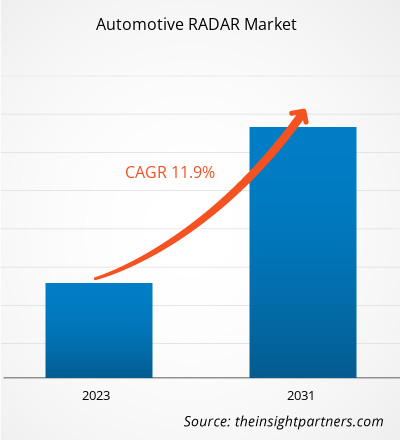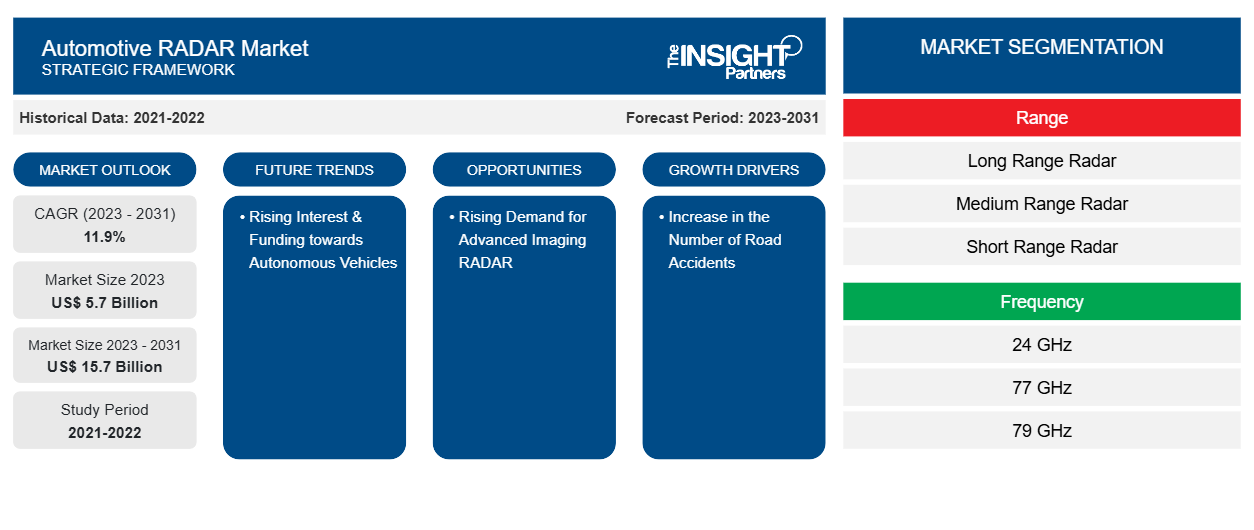Si prevede che il mercato dei radar per autoveicoli raggiungerà i 15,7 miliardi di dollari entro il 2031, rispetto ai 5,7 miliardi di dollari del 2023. Si prevede che il mercato registrerà un CAGR dell'11,9% nel 2023-2031. L'aumento dell'adozione dei radar per autoveicoli nei sistemi avanzati di assistenza alla guida per fornire funzionalità quali il cruise control adattivo (ACS), l'assistenza al cambio di corsia, la frenata di emergenza, il rilevamento degli angoli ciechi e altri sono tra i fattori chiave che alimentano la crescita del mercato dei radar per autoveicoli.
Analisi del mercato dei radar automobilistici
Si prevede che il mercato dei radar per autoveicoli registrerà una crescita considerevole durante il periodo di tempo analizzato a causa dell'aumento delle normative governative in materia di sicurezza dei veicoli, della crescente adozione di veicoli premium, del crescente numero di radar utilizzati in un veicolo. Inoltre, si prevede che l'aumento della produzione e dell'adozione di veicoli elettrici (EV) supporterà ulteriormente la crescita del mercato dei radar per autoveicoli. Si prevede che nei prossimi anni la guida autonoma sarà una tendenza in crescita. Per raggiungere questo obiettivo, sono aumentate diverse tecnologie di visione con l'intento di fornire funzionalità e sicurezza ai conducenti e ai passeggeri del veicolo.
Panoramica del mercato dei radar per autoveicoli
I sistemi radar sono le tecnologie più consolidate e affidabili nelle varie tecnologie visive del settore automobilistico. Attualmente, diversi produttori di veicoli sono impegnati a fornire una tecnologia di automazione di "livello 3" in cui i conducenti sono in standby per un periodo di tempo specifico. Questi veicoli sono integrati con cinque sistemi radar, tra cui SSR e LLR, per applicazioni che includono frenata di emergenza o cruise control adattivo. Inoltre, si prevede che l'elevata domanda di tecnologia RADAR nel settore automobilistico, dovuta ai vantaggi ad essa associati, tra cui prestazioni in tutte le condizioni atmosferiche, misurazione diretta della velocità, rilevamento non in linea di vista, convenienza e altri, guiderà il mercato durante il periodo di previsione.
Personalizza questo report in base alle tue esigenze
Riceverai la personalizzazione gratuita di qualsiasi report, comprese parti di questo report, o analisi a livello nazionale, pacchetto dati Excel, oltre a usufruire di grandi offerte e sconti per start-up e università
-
Scopri le principali tendenze di mercato in questo rapporto.Questo campione GRATUITO includerà analisi di dati che spaziano dalle tendenze di mercato alle stime e alle previsioni.
Driver e opportunità del mercato dei radar automobilistici
Aumento del numero di incidenti stradali.
Gli incidenti stradali sono una preoccupazione pubblica fondamentale affrontata dai governi di tutto il mondo e la crescente prevalenza degli incidenti stradali ostacola lo sviluppo del mercato in quei paesi. Secondo i dati dell'Organizzazione mondiale della sanità (OMS), circa 1,19 milioni di persone muoiono a causa di incidenti stradali. La maggior parte degli incidenti stradali si verificano nelle economie in via di sviluppo e sviluppate e sono dovuti a errori di guida umani. Mentre la tecnologia di sicurezza dei veicoli è migliorata in modo significativo negli ultimi decenni con l'avvento dei sistemi avanzati di assistenza alla guida (ADAS) e la prospettiva dei veicoli autonomi, questi numeri mostrano che la sicurezza dei veicoli deve migliorare a un ritmo molto più rapido e suggeriscono la necessità di adottare tecnologie di guida automatizzata che possono aiutare a ridurre drasticamente il numero di vittime eliminando l'errore umano del conducente dall'equazione. Quindi, si prevede che l'aumento del numero di incidenti stradali stimoli la domanda di sistemi RADAR per autoveicoli, che a sua volta dovrebbe alimentare la crescita del mercato nei prossimi anni.
Crescente domanda di radar di imaging avanzato
Con il crescente numero di veicoli di livello 2+ su strada, la necessità di sensori radar automobilistici avanzati e più precisi sta aumentando. Ciò rappresenta un'enorme opportunità per gli OEM di offrire sensori radar di livello base. Ad esempio, Xilinx e Continental hanno annunciato il primo radar di imaging 4D pronto per la produzione. In teoria, il radar di imaging 4D utilizza l'ecolocalizzazione (un meccanismo osservato nei delfini, nei pipistrelli e in diversi esseri umani) e il principio di misurazione del tempo di volo per catturare uno spazio in 3D. Inoltre, questi sistemi radar sono progettati per soddisfare i requisiti di imaging entro la scala temporale di un'automobile in rapido movimento o di un drone in zoom. Pertanto, la quarta dimensione migliora la precisione complessiva di un sistema di guida autonoma. Il radar di imaging 4D è operativo in tutti i tipi di condizioni meteorologiche/ambientali, tra cui nebbia, oscurità e forti piogge. Numerose aziende stanno investendo in R&S per introdurre tali tecnologie di imaging basate su radar avanzate e ottenere una quota massima nel mercato globale dei radar automobilistici.OEMs to offer basic-level radar sensors. For instance, Xilinx and Continental announced the first production-ready 4D imaging radar. Theoretically, 4D imaging radar uses echolocation (a mechanism that is observed in dolphins, bats, and several humans) and the time-of-flight measurement principle to capture a space in 3D. Furthermore, these
Analisi della segmentazione del rapporto di mercato sui radar automobilistici
I segmenti chiave che hanno contribuito alla derivazione dell'analisi di mercato dei radar per autoveicoli sono la portata, la frequenza, l'applicazione e il tipo di veicolo.
- In base alla portata, il mercato dei radar per autoveicoli è stato suddiviso in radar a lungo raggio (LRR), radar a medio raggio (MRR) e radar a corto raggio (SRR). Il segmento dei radar a corto raggio ha detenuto una quota di mercato maggiore nel 2023.
- In base alla frequenza, il mercato Automotive RADAR è stato suddiviso in 24 GHz, 77 GHz e 79 GHz. Il segmento 77 GHz ha detenuto una quota di mercato maggiore nel 2023.
- Sulla base dell'applicazione, il mercato è stato segmentato in cruise control adattivo (ACS), frenata di emergenza autonoma, rilevamento degli angoli ciechi, sistema di avviso di collisione frontale, assistenza al parcheggio intelligente e altri. Il segmento del cruise control adattivo ha dominato il mercato nel 2023.
- In base al tipo di veicolo, il mercato Automotive RADAR è stato suddiviso in autovetture, veicoli commerciali leggeri e veicoli commerciali medi e pesanti. Il segmento delle autovetture ha detenuto una quota di mercato maggiore nel 2023.
Analisi della quota di mercato dei radar automobilistici per area geografica
L'ambito geografico del rapporto di mercato Automotive RADAR è suddiviso principalmente in cinque regioni: Nord America, Europa, Asia Pacifico, Medio Oriente e Africa e Sud America.
L'Asia Pacifica ha dominato il mercato dei radar per autoveicoli nel 2023. La regione Asia Pacifica comprende Cina, India, Giappone, Corea del Sud e il resto d'Europa. Le iniziative governative, come "Made in China 2025" e "Made in India", stanno catalizzando la crescita del settore automobilistico nella regione. I miglioramenti nelle infrastrutture, gli aumenti nei consumi interni e i bassi costi della manodopera nei paesi del sud-est asiatico sono i fattori chiave che stanno attraendo le aziende automobilistiche in questa regione. Inoltre, si prevede che un aumento degli investimenti nella ricerca e nello sviluppo delle tecnologie automobilistiche alimenterà la crescita del mercato dei radar per autoveicoli nei prossimi anni. Inoltre, si prevede che i crescenti sforzi dei giganti dell'automotive nell'ottimizzazione delle auto automatizzate alimenteranno in modo significativo la vendita di veicoli elettrici nei paesi APAC come India, Malesia, Singapore e Thailandia. Ad esempio, nell'ottobre 2022, la società statunitense denominata Magna International ha investito oltre 120 milioni di dollari nella creazione e gestione di nuovi centri di ingegneria a Bengaluru, in India.
Approfondimenti regionali sul mercato dei radar automobilistici
Le tendenze regionali e i fattori che influenzano il mercato Automotive RADAR durante il periodo di previsione sono stati ampiamente spiegati dagli analisti di Insight Partners. Questa sezione discute anche i segmenti e la geografia del mercato Automotive RADAR in Nord America, Europa, Asia Pacifico, Medio Oriente e Africa e Sud e Centro America.

- Ottieni i dati specifici regionali per il mercato dei radar automobilistici
Ambito del rapporto sul mercato dei radar automobilistici
| Attributo del report | Dettagli |
|---|---|
| Dimensioni del mercato nel 2023 | 5,7 miliardi di dollari USA |
| Dimensioni del mercato entro il 2031 | 15,7 miliardi di dollari USA |
| CAGR globale (2023-2031) | 11,9% |
| Dati storici | 2021-2022 |
| Periodo di previsione | 2023-2031 |
| Segmenti coperti |
Per intervallo
|
| Regioni e Paesi coperti |
America del Nord
|
| Leader di mercato e profili aziendali chiave |
|
Densità degli attori del mercato dei radar automobilistici: comprendere il suo impatto sulle dinamiche aziendali
Il mercato Automotive RADAR Market sta crescendo rapidamente, spinto dalla crescente domanda degli utenti finali dovuta a fattori quali l'evoluzione delle preferenze dei consumatori, i progressi tecnologici e una maggiore consapevolezza dei vantaggi del prodotto. Con l'aumento della domanda, le aziende stanno ampliando le loro offerte, innovando per soddisfare le esigenze dei consumatori e capitalizzando sulle tendenze emergenti, il che alimenta ulteriormente la crescita del mercato.
La densità degli operatori di mercato si riferisce alla distribuzione di aziende o società che operano in un particolare mercato o settore. Indica quanti concorrenti (operatori di mercato) sono presenti in un dato spazio di mercato in relazione alle sue dimensioni o al valore di mercato totale.
Le principali aziende che operano nel mercato dei radar per autoveicoli sono:
- Bosch Italia S.p.A.
- Continentale AG
- Società Denso
- Società per azioni Aptiv
- Hella GmbH & Co. KGaA
- Valeo
Disclaimer : le aziende elencate sopra non sono classificate secondo un ordine particolare.

- Ottieni una panoramica dei principali attori del mercato Automotive RADAR
Notizie e sviluppi recenti del mercato dei radar automobilistici
Il mercato Automotive RADAR viene valutato raccogliendo dati qualitativi e quantitativi dopo la ricerca primaria e secondaria, che include importanti pubblicazioni aziendali, dati associativi e database. Di seguito è riportato un elenco degli sviluppi nel mercato per il mercato Automotive RADAR e le strategie:
- A gennaio 2021, l'azienda ha introdotto la piattaforma di sistemi avanzati di assistenza alla guida (ADAS) di livello 1-3 di nuova generazione. Questa soluzione ADAS è conveniente ed efficiente, rafforzando quindi il portafoglio prodotti dell'azienda.
- A settembre 2023, Valeo ha stretto una partnership con Mobileye. Questa partnership mirava allo sviluppo di radar di imaging best-in-class definiti dal software per le funzionalità di assistenza alla guida e guida automatizzata di prossima generazione.
Copertura e risultati del rapporto sul mercato dei radar automobilistici
Il rapporto "Dimensioni e previsioni del mercato dei radar automobilistici (2021-2031)" fornisce un'analisi dettagliata del mercato che copre le seguenti aree:
- Dimensioni e previsioni del mercato a livello globale, regionale e nazionale per tutti i segmenti di mercato chiave coperti dall'ambito
- Dinamiche di mercato come fattori trainanti, vincoli e opportunità chiave
- Principali tendenze future
- Analisi dettagliata delle cinque forze di Porter
- Analisi di mercato globale e regionale che copre le principali tendenze di mercato, i principali attori, le normative e gli sviluppi recenti del mercato
- Analisi del panorama industriale e della concorrenza che copre la concentrazione del mercato, l'analisi della mappa di calore, i principali attori e gli sviluppi recenti
- Profili aziendali dettagliati con analisi SWOT
- Analisi storica (2 anni), anno base, previsione (7 anni) con CAGR
- Analisi PEST e SWOT
- Valore/volume delle dimensioni del mercato - Globale, Regionale, Nazionale
- Industria e panorama competitivo
- Set di dati Excel
Report recenti
Rapporti correlati
Testimonianze
Motivo dell'acquisto
- Processo decisionale informato
- Comprensione delle dinamiche di mercato
- Analisi competitiva
- Analisi dei clienti
- Previsioni di mercato
- Mitigazione del rischio
- Pianificazione strategica
- Giustificazione degli investimenti
- Identificazione dei mercati emergenti
- Miglioramento delle strategie di marketing
- Aumento dell'efficienza operativa
- Allineamento alle tendenze normative























 Ottieni un campione gratuito per - Mercato dei radar automobilistici
Ottieni un campione gratuito per - Mercato dei radar automobilistici